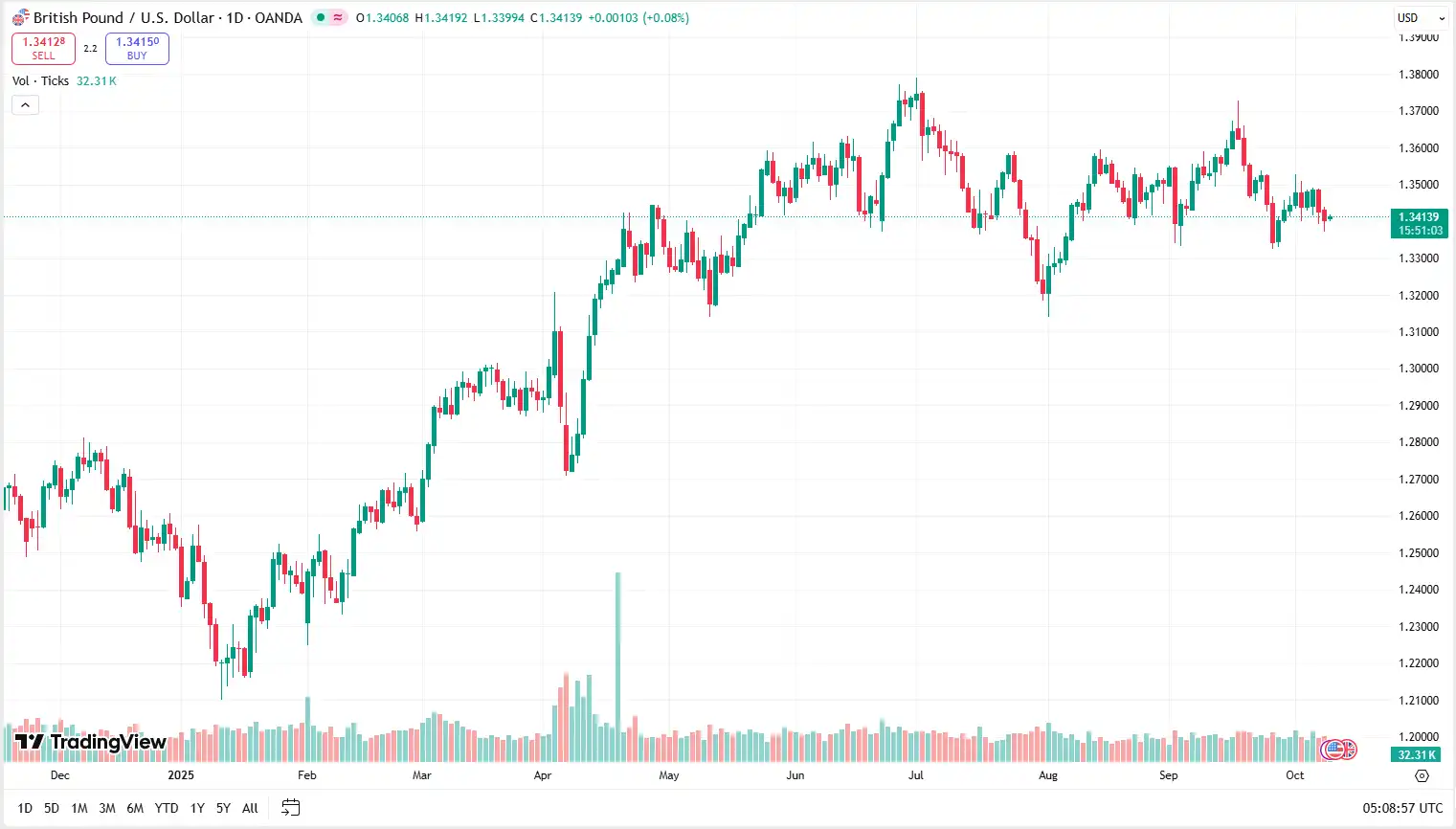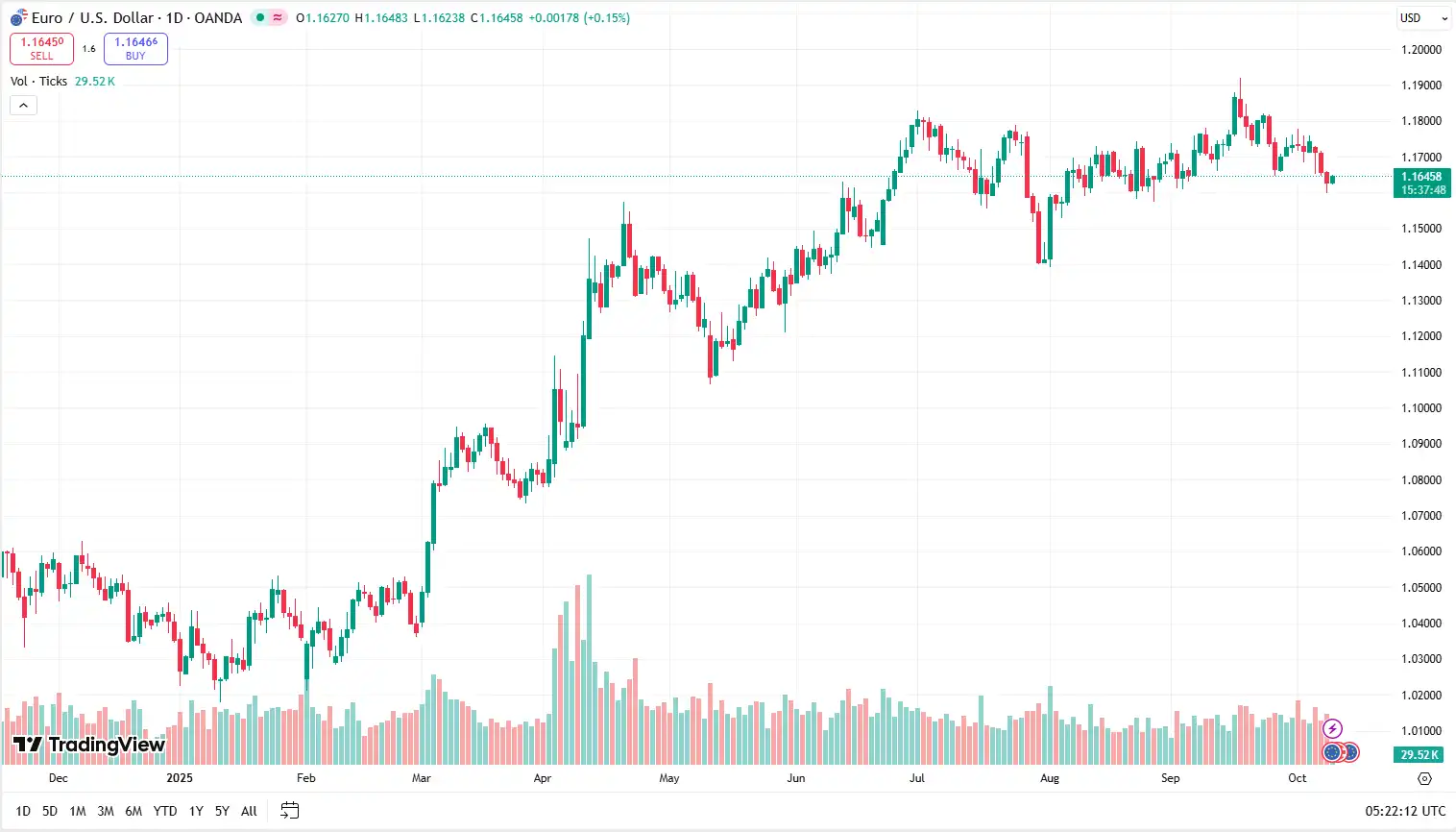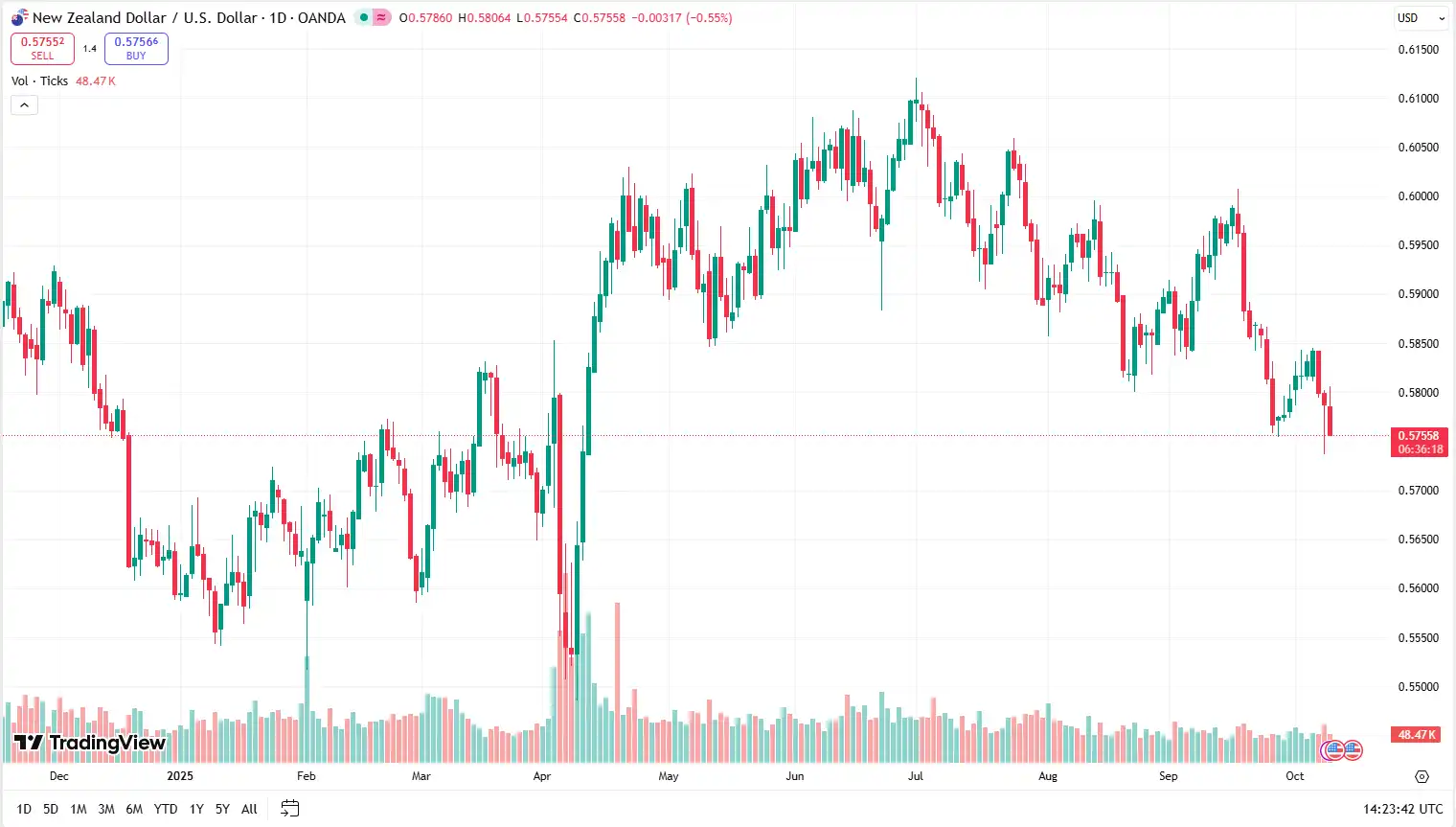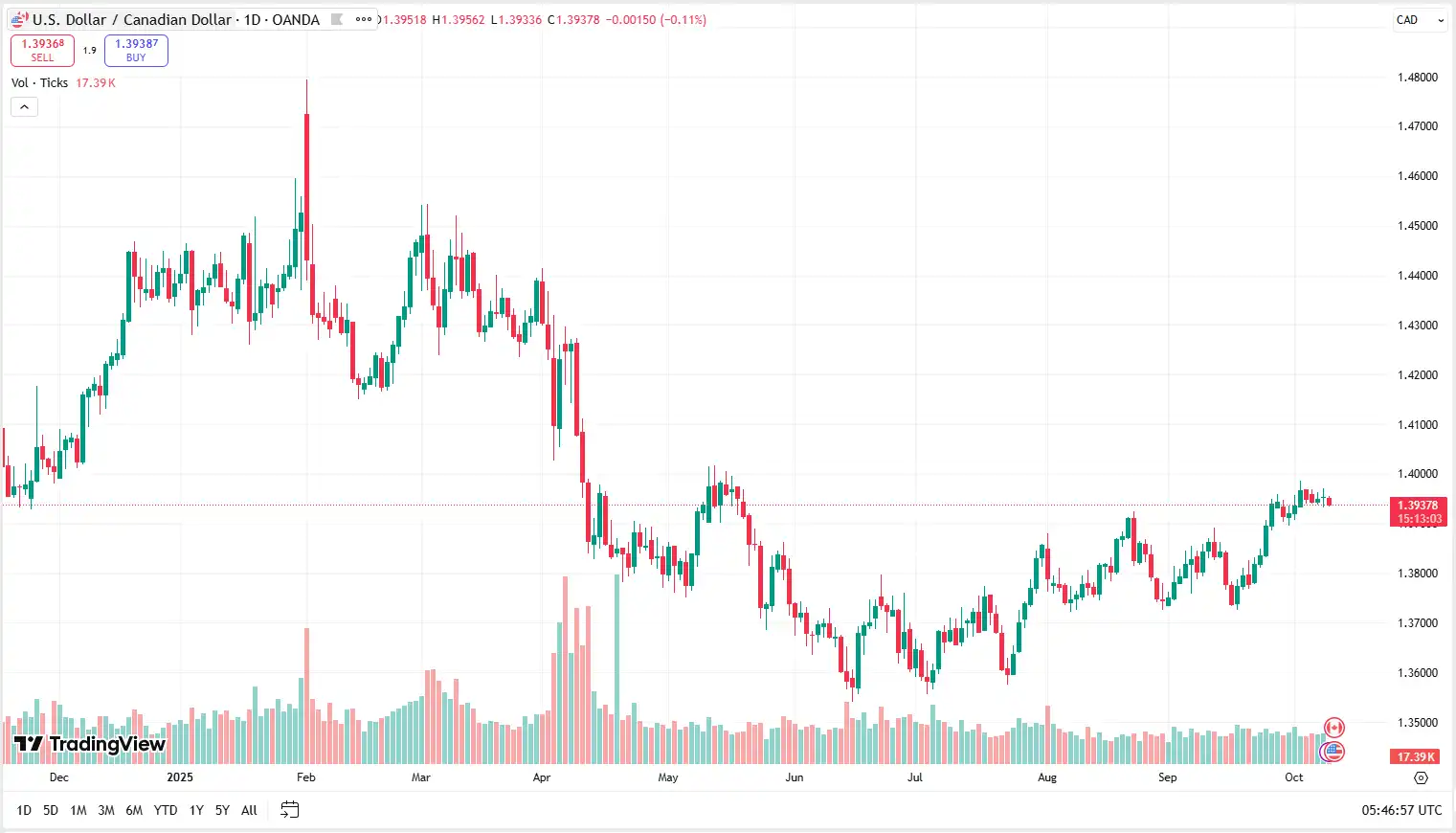The GBP/USD pair traded near 1.3405[1] in Thursday's early Asian trading, rebounding from a two-day decline as the US dollar softened amid rising concerns over a prolonged US government shutdown. The current deadlock, in its ninth day, is said to continue to dampen investor confidence, especially with the suspension of operations at major agencies such as the Bureau of Labour Statistics and Bureau of Economic Analysis[2] postponing the release of important economic data. The lack of revised signals makes it difficult to assess policy by the Federal Reserve (Fed) and restricts market visibility, putting the Greenback under slight downward pressure.
Market reports point out that the Fed September minutes[3] meeting indicated that the majority of the policymakers supported the last month rate cut and appeared ready to move more later this year but few cautioned about taking radical action due to the continued risks of high inflation. Traders are closely paying attention to the Fed Chair Jerome Powell[4] speech later today in search of further indications of rate policy and economic perspective.
On the UK side, market commentators note, the statements by Bank of England (BoE) Chief Economist Huw Pill[5], suggesting that the pound should be run in a conservative way, included a note of care to the long-term prognosis of the pound. Although the close bias towards GBP/USD is still slightly bullish with the US dollar weak, the movement can be limited by the uncertainty about the next BoE policy action.
Analysts[6] point out that in the short term, the two can be supported by 1.3370 and resisted by 1.3450. Further sentiment could depend on future US macro releases- in case the shutdown postpones major reports like CPI or retail sales, market volatility may rise again, and the dollar would be at risk of new selling off.

EUR/USD Recovers as Shutdown Weakens Dollar
The EUR/USD pair staged a modest recovery and traded around 1.1645[7] in Thursday’s Asian session, after three consecutive days of losses. The recovery is felt to be in the fact that the US dollar is unwinding as concerns continue to pile up about the current US government shutdown[8] which is the ninth day. As major agencies like the Bureau of Labour Statistics and Bureau of Economic Analysis[9] halt data gathering, the invisibility of the economy may make the policy direction of the Fed more challenging and load the Greenback down in the short term.
Investors are keenly anticipating what Fed Chairman Jerome Powell[10] says to see the future of the policy after the September FOMC meeting showed a split between most officials supporting a cut in the rate, and a minority launching a warning about overeasing in the face of still-existent inflationary pressures. No new data releases like nonfarm payrolls or inflation rates because of the shutdown further obscures the near-term US dollar, which could favour EUR/ US dollar.
Market commentators note that on the Euro side, however, political uncertainty in France with the resignation of Prime Minister Sebastien Lecornu[11] and growing pressure on President Emmanuel Macron is a headwind to the single currency. Investors are worried that renewed political uncertainty in the second-largest economy of the Eurozone can curtail the upside of the Euro.
Analysts[12] highlight that the pair of EUR/USD may be supported in short-term up to 1.162011650 as the dollar weakens, but the wider risk sentiment and geopolitics in Europe may limit the profits. In the medium term, the direction of the duo will depend on the speed at which the US cracks its budget lock and whether future Fed communications are a prelude of further easing by year-end.

NZD/USD Rebounds Amid Dovish RBNZ Outlook
The NZD/USD pair extended its rebound from a six-month low near 0.5735[13] and traded near 0.5800 in Thursday’s Asian session. The move is thought to have been pushed to a large degree by the humble US dollar weakness, given that the traders cut long-US dollar positions after a pullback of the Treasury[14] yields and increasing uncertainty about the economic effect a US government shutdown could have. The recovery, however, is cautious due to the dovish policy shift as announced by the Reserve Bank of New Zealand (RBNZ)[15] earlier this week.
Market commentators[16] note that the RBNZ has surprised markets by reducing the Official Cash Rate by 50 bps to 2.50% indicating that the bank is willing to go further to stabilize the inflation rate around its 2% midpoint. This sudden aggressive nature has dampened the Kiwi zeal with investors analysing the possibility of further rate cuts in the near future. The dovish nature is against the current Fed[17] tone but weaker US data and policy doubts are weakening the US dollar, which is a short-term aid to the pair.
Market analysts[18] note that investors are currently looking forward to the next speech of the scheduled Fed Chairman Jerome Powell who may provide new indications of when and how much the US should lower its rates. Meanwhile, no major US data releases[19], and poor recent prints in ISM services and labour market indicators, supports the belief that the US economy will slow down, which could limit US dollar gains in the short term.
Market commentators[20] point out that technically, the rejection of NZD/USD at the 200-day SMA reflects a long-term upside resistance of 0.5830-0.5850. Although the short-term bias is a bit bullish above 0.5780, there are medium-term risks which are more to the downside, especially when the global risk mentality starts waning, or the dovish bias of RBNZ continues to increase.

USD/CAD Retreats as Dollar Weakens Broadly
The USD/CAD pair slipped lower and traded around 1.3940[21] in Thursday's early session, retreating toward the level after two consecutive sessions of gains. The pullback is believed to follow the release of the Federal Open Market Committee (FOMC) Minutes[22] of the September meeting with the US dollar getting fresh selling pressure. The minutes indicated that most policymakers have decided it is proper to loosen further monetary policy this year, with a more dovish message as more fears emerge about employment and decreasing inflation risks.
Market commentators[23] observe that market sentiment towards the greenback also deteriorated with the ongoing US government shutdown into the 9th day, and no sign of compromise between Republicans and Democrats. The extended political stalemate has created further uncertainty in the short-term economic forecast, and solidifies the anticipation of further policy support by the Federal Reserve (Fed)[24]. Poor US economic indicators, including subpar labour market data and declining consumer expenditure, have also contributed to the increased pressure on Treasury yields and restricted the potential of the US dollar to gain.
Market commentators[25] note that on the Canadian side, the move by the Bank of Canada (BoC) in September to reduce its overnight rate by 25 basis points to 2.50% highlighted its increasingly anxious attitude towards slowing growth and moderating inflation. Nonetheless, a relatively moderate stance of the BoC[26] relative to the expected policy tightening by the Fed can offer some medium-term protection to the Canadian dollar. Markets are already anticipating another policy announcement by the BoC on October 29.
Analysts[27] suggest that in the future, future US economic reports such as inflation rates, jobless claims, and consumer sentiment numbers will be carefully examined to ensure that economic momentum is declining. Although the USD/CAD could find short-term support in the 1.3900 area, the long-run vulnerability of the US data may increase the downward bias of the pair in the medium term.

Stay Ahead in the Currency Game
Whether you're a daily FX trader or handle international transactions regularly, our 'Currency Pulse' newsletter delivers the news you need to make more informed decisions. Receive concise updates and in-depth insights directly in your LinkedIn feed.
Subscribe to 'Currency Pulse' now and never miss a beat in the currency markets!
Ready to act on today’s insights? Get a free quote or give us a call on: +44 (0)20 7740 0000 to connect with a dedicated portfolio manager for tailored support.
Important Disclaimer: This blog is for informational purposes only and should not be considered financial advice. Currency Solutions does not take into account the investment objectives, financial situation, or specific needs of any individual readers. We do not endorse or recommend any specific financial strategies, products, or services mentioned in this content. All information is provided “as is” without any representations or warranties, express or implied, regarding its accuracy, completeness, or timeliness.




